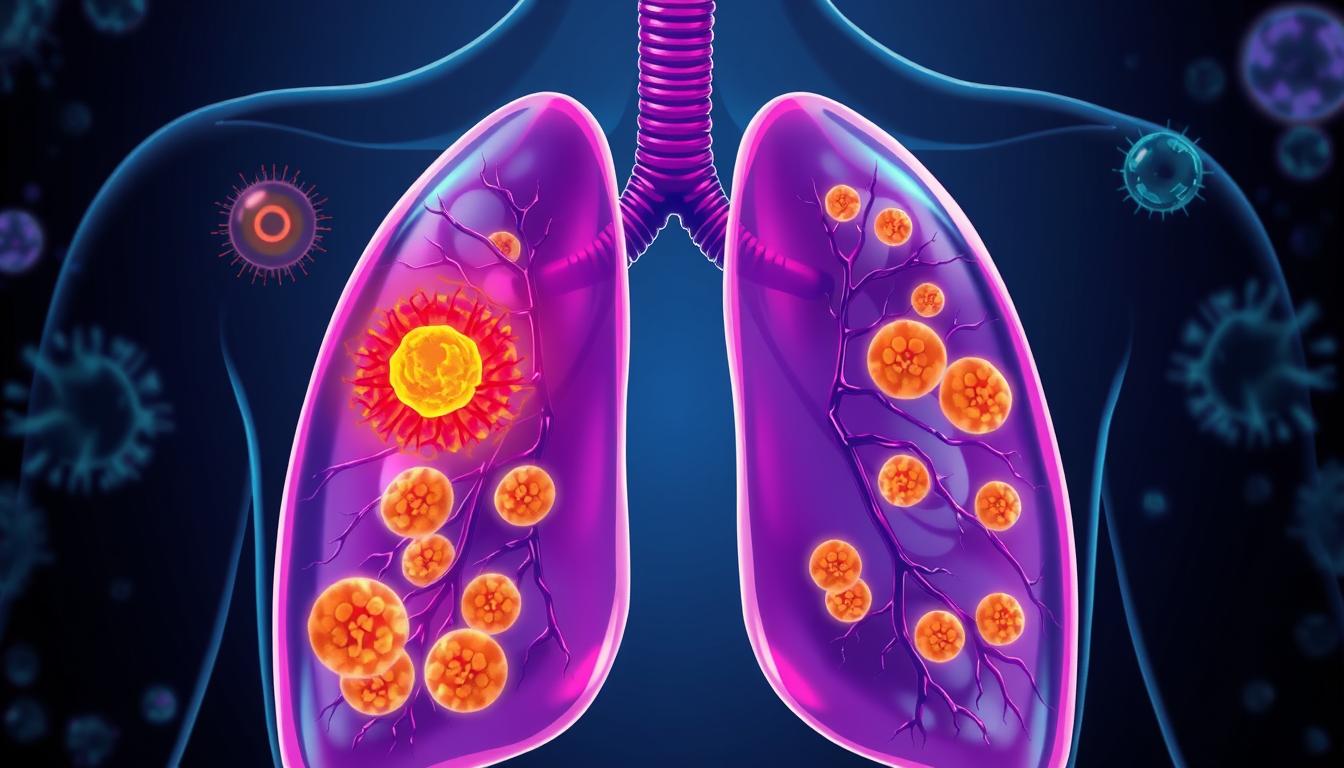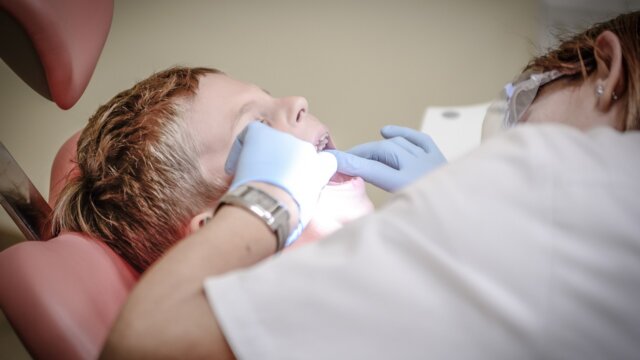FTC disclaimer: This post may contains affiliate links and we will be compensated if you click on a link and make a purchase.
Lung cancer is a big killer in the U.S., taking about 135,000 lives each year. Non-small cell lung cancer (NSCLC) is a big part of this, making up about 85% of lung cancer cases. Knowing about NSCLC is key to getting the right treatment fast.
NSCLC has many types, like adenocarcinoma, squamous cell carcinoma, and large cell carcinoma. Adenocarcinoma is the most common, making up half of NSCLC cases. Squamous cell carcinoma often starts in the tracheobronchial tree. Large cell carcinoma is identified by what it’s not, usually showing signs of squamous, glandular, or neuroendocrine differentiation.
Key Takeaways
- Non-small cell lung cancer (NSCLC) is the most common type of lung cancer, accounting for approximately 85% of all lung cancer diagnoses.
- Adenocarcinoma, squamous cell carcinoma, and large cell carcinoma are the primary subtypes of NSCLC, with adenocarcinoma being the most prevalent.
- Tobacco use is the dominant risk factor for NSCLC, contributing to around 90% of lung cancer cases, especially in individuals with a significant smoking history.
- Lung cancer is a leading cause of cancer deaths worldwide, being the most common cause in men and the second most common in women.
- Despite the grim statistics, the age-adjusted mortality rate of lung cancer in the United States is projected to decrease by 79% between 2015 and 2065 due to decreased tobacco use and anti-smoking campaigns.
What is Non-Small Cell Lung Cancer?
Non-small cell lung cancer (NSCLC) is a disease where cancer cells grow in the lung. It’s the most common lung cancer, making up 80% to 85% of cases. NSCLC has several subtypes, each with its own growth pattern.
Types of Non-Small Cell Lung Cancer
The main types of non-small cell lung cancer include:
- Adenocarcinoma: The most common type, found in the outer lung. It’s more common in women.
- Squamous cell carcinoma: Often linked to smoking.
- Large cell carcinoma: This type grows and spreads fast, making it hard to treat.
Other less common types include carcinoid tumors, which grow slowly and make up less than 5% of lung tumors. Lung cancers that start in other organs and spread to the lungs are not NSCLC.
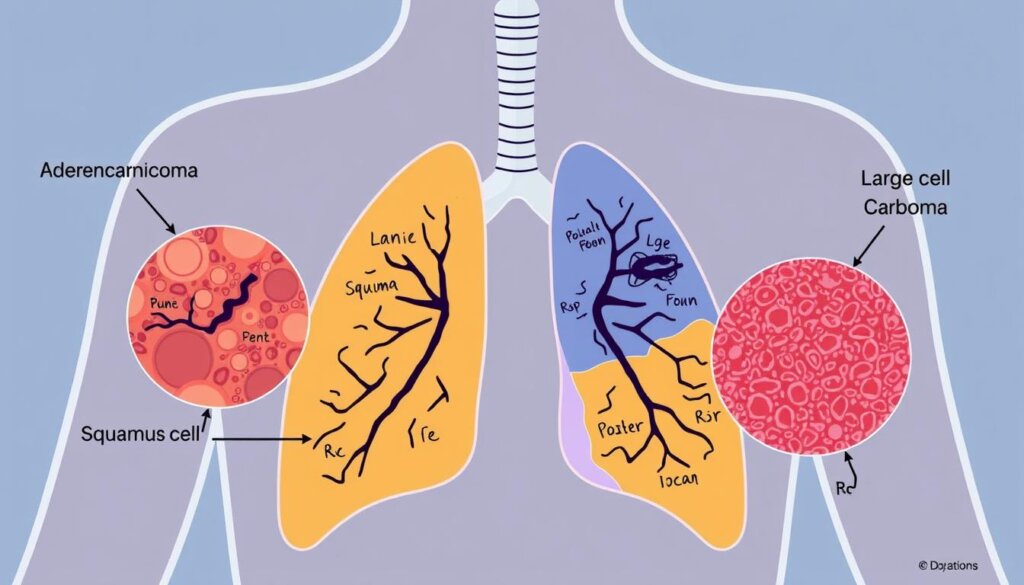
Knowing the different types of NSCLC is key, as each needs a specific treatment. Accurate diagnosis and staging are vital for a good treatment plan.
Causes and Risk Factors
The main risk for non-small cell lung cancer is smoking. About 80% of lung cancer deaths come from smoking. The sooner you start smoking, the more you risk lung cancer. Secondhand smoke also raises lung cancer risk.
Other risks include radon, asbestos, outdoor pollution, radiation therapy, family history, and genetics. Radon is a big risk for lung cancer in the U.S., especially for non-smokers. People exposed to asbestos face a higher risk of lung cancer, especially if they smoke.
Smoking marijuana’s effect on lung cancer is unclear because of study challenges. E-cigarettes don’t seem to lower lung cancer risk, and their link to lung cancer is still a mystery.
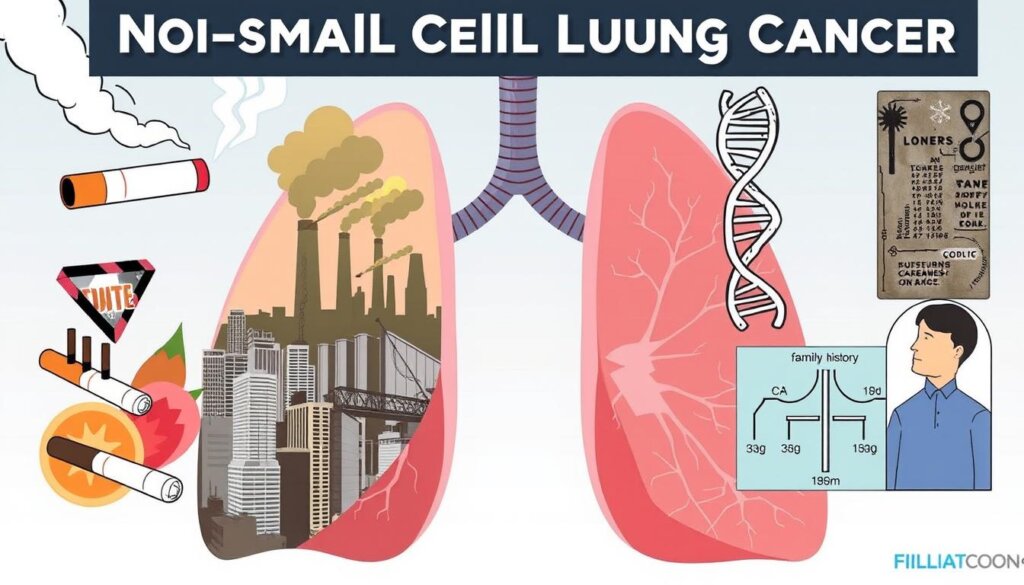
Symptoms of Non-Small Cell Lung Cancer
Common Signs and Symptoms
Non-small cell lung cancer (NSCLC) might not show symptoms early on. But as it grows, you might notice a cough that won’t go away or gets worse. You could also cough up blood, feel pain in your chest, or have trouble breathing.
Other signs include hoarseness, losing your appetite, and losing weight without trying. You might feel very tired, have trouble breathing, or get sick a lot. Wheezing can also be a sign of NSCLC.
If the cancer spreads, you might feel pain in your bones or have headaches and weakness. You could also notice yellow skin and eyes, swollen lymph nodes, or other specific syndromes. Pancoast tumors, a type of NSCLC, can cause droopy eyelids and other symptoms.
The superior vena cava syndrome, caused by NSCLC, can make your face and arms swell. You might also have trouble breathing and need urgent treatment.
Some symptoms can mean other health issues too. It’s key to see a doctor right away for the right diagnosis and treatment. Finding and treating NSCLC early can help a lot.
Symptom | Description |
|---|---|
Persistent or worsening cough | A cough that does not go away or gets worse over time |
Coughing up blood | Expelling blood or blood-tinged mucus when coughing |
Chest pain | Pain or discomfort in the chest, which may worsen with deep breathing or coughing |
Hoarseness | A raspy, strained, or abnormal-sounding voice |
Loss of appetite | Decreased desire or ability to eat |
Unexplained weight loss | Losing weight without trying or without a clear reason |
Shortness of breath | Difficulty breathing or feeling like you can’t get enough air |
Fatigue or weakness | Feeling unusually tired or lacking in energy |
Recurring respiratory infections | Frequent or persistent lung or respiratory infections |
Wheezing | A high-pitched whistling sound during breathing |
Having these symptoms doesn’t always mean you have NSCLC. They can also be signs of other health problems. If you notice any of these, it’s important to talk to a doctor.
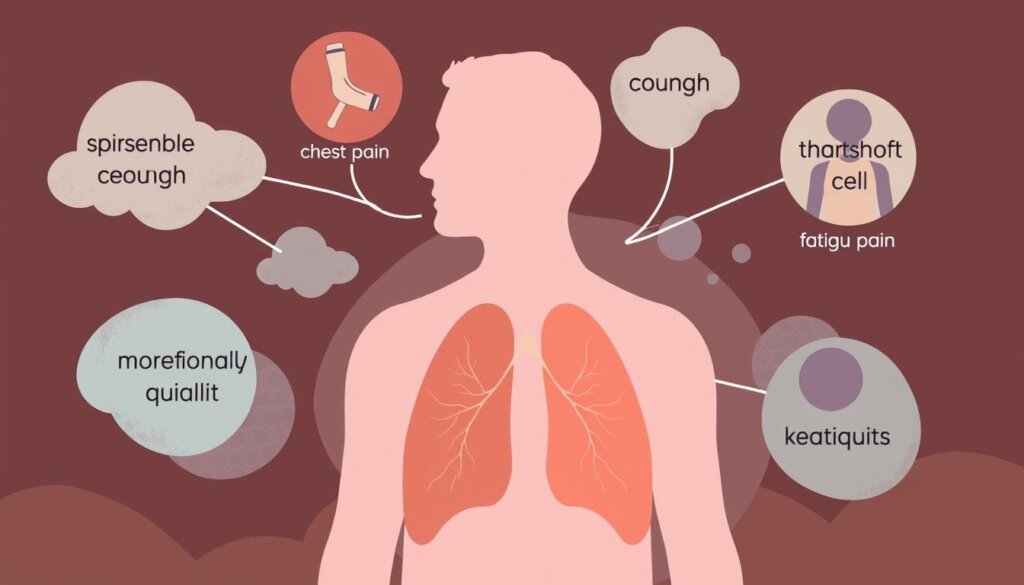
Diagnosis and Staging
Diagnosing non-small cell lung cancer needs several tests and procedures. First, a doctor will do a physical exam and take your medical history. Then, imaging tests like a chest X-ray, CT scan, or PET scan are used to see the tumor’s size and where it is.
If tests show lung cancer, a biopsy is next. This means taking a small piece of the tumor for a microscope check.
After confirming lung cancer, your doctor will find out how far it has spread. This is called staging. It looks at the tumor’s size, location, and if it has spread to lymph nodes or other parts. Knowing this helps decide the best treatment.
Staging Category | Description |
|---|---|
Stage 0 | Carcinoma/tumor in-situ, confined to the top lining of the lung or bronchus without spread. |
Stage I | Further divided into sub-stages 1A and 1B, characterized by the lack of spread to lymph nodes or other organs. |
Stage II | Divided into IIA and IIB, where tumors are larger or have spread to nearby lymph nodes but not to distant organs. |
Stage III | Includes sub-stages IIIA, IIIB, or IIIC, with common lymph node involvement in the mediastinum. |
Stage IV | Represents the most advanced form of non-small cell lung cancer, where cancer has metastasized. |
The TNM system is used to further classify the stage of non-small cell lung cancer. It looks at the tumor’s size, lymph node involvement, and distant metastases.
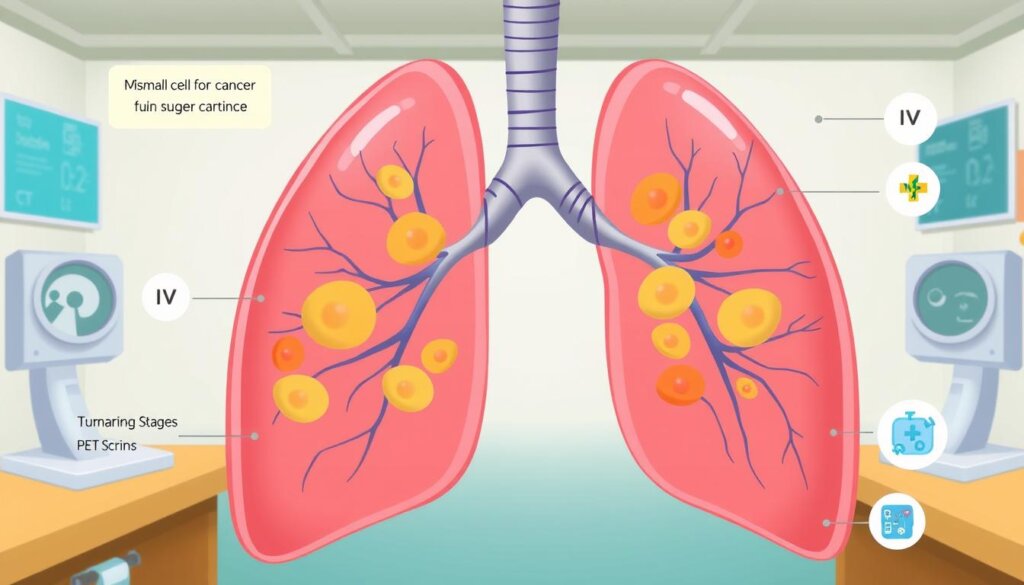
Knowing the exact stage of non-small cell lung cancer is key for choosing the right treatment. It also helps predict your outcome and guides your healthcare team in tracking your condition.
Treatment Options
The treatment for non-small cell lung cancer (NSCLC) varies based on several factors. These include the disease stage, cancer type, and the patient’s health. Common treatments include surgery, radiation, chemotherapy, targeted therapy, and immunotherapy.
First-Line Treatments
For early-stage NSCLC, like stage 0 or stage I, surgery is often the first choice. This might be segmentectomy, wedge resection, or lobectomy, depending on the tumor’s size and location. Sometimes, photodynamic therapy, laser therapy, or brachytherapy are considered.
For more advanced stages, a mix of treatments is used. This can include chemotherapy, radiation, targeted therapy, or immunotherapy before or after surgery. A team of healthcare experts will decide the best plan for you.
Targeted therapies and immunotherapies are newer options for some NSCLC types. They target specific genetic mutations or boost the immune system to fight cancer.
In stage IV NSCLC, the goal is to extend life and ease symptoms. Treatments may include surgery, chemotherapy, targeted therapy, immunotherapy, and radiation. Clinical trials for new treatments are also considered.
NSCLC treatment plans are carefully made to improve your chances of the best outcome. Regular check-ups and monitoring are key to track treatment success and manage side effects.
Treatment Option | Stage | Description |
|---|---|---|
Surgery | Early-stage (0, I) | Procedures like segmentectomy, wedge resection, or lobectomy |
Radiation Therapy | Early-stage (0, I) | Stereotactic ablative body radiotherapy (SABR) or conventional radiotherapy |
Chemotherapy | Stages II-IV | Neoadjuvant (before surgery) or adjuvant (after surgery) treatment |
Targeted Therapy | Stages III-IV | Drugs targeting specific genetic mutations in NSCLC |
Immunotherapy | Stages III-IV | Drugs that boost the body’s immune system to fight cancer |
“The treatment for non-small cell lung cancer depends on the stage of the disease, the specific type of cancer, and the patient’s overall health.”
Remember, regular follow-up care and monitoring are essential to ensure the effectiveness of the treatment and manage any side effects. Your healthcare team will work with you to develop the most appropriate treatment plan for your individual needs.
Recovery and Follow-Up
After treatment for non-small cell lung cancer, recovery and follow-up care are key. The recovery path varies based on disease stage, treatment, and health. Regular follow-up appointments are vital to track your health, manage treatment side effects, and ensure your long-term health.
Your healthcare team will check your health, do physical exams, and order tests like CT scans or chest X-rays during follow-ups. These tests look for signs of cancer or new lung cancers. Lung cancer patients are at high risk for a second lung cancer.
- Keep your health insurance to get the care and tests you need.
- Talk to your doctor about a survivorship care plan that fits your needs.
- Live a healthy lifestyle, like quitting smoking, eating well, and staying active. This may lower cancer risk.
If cancer comes back, your team will help create a new treatment plan. The risk of cancer coming back is highest in the first two years after treatment.
“Regular follow-up care is essential for lung cancer survivors to monitor their health and catch any potential recurrences or new cancers early.”
You’re not alone in this journey. Look for support from groups, counseling, and cancer organizations.
By being active in your follow-up care and staying healthy, you can boost your recovery chances. This also lowers the risk of cancer coming back or a new lung cancer.
Non-Small Cell Lung Cancer Screening
Screening for non-small cell lung cancer is key to early detection. This is vital for effective treatment. The best method is the low-dose computed tomography (LDCT) scan.
In the United States, lung cancer is the second most common cancer. It’s also the leading cause of cancer deaths. The American Cancer Society suggests yearly LDCT scans for those aged 50 to 80. This is for those who have smoked at least 20 pack years.
A pack-year is smoking one pack (about 20 cigarettes) per day for a year.
LDCT scans are better at finding lung cancer early than regular chest X-rays. Chest X-rays are not recommended for screening because they don’t help much. LDCT scans can lower lung cancer death rates by 20% and all-cause mortality by 6.7% in high-risk groups.
LDCT scans use a small amount of radiation. It’s more than a chest x-ray but less than a standard CT scan. It’s important to get the scan at a place with the right CT scanners and skilled staff.
People getting LDCT scans often get help to quit smoking. This can improve their survival chances. It’s important to talk to a healthcare professional about the screening. They can explain the benefits, limitations, and risks.
Screening Approach | Effectiveness | Radiation Exposure |
|---|---|---|
Chest X-ray | Limited | Low |
Low-Dose CT (LDCT) Scan | Effective | Moderate |
In summary, LDCT scans can find lung cancer early. This improves treatment chances and survival. Talk to a healthcare professional to see if you should get screened.
Targeted Therapies and Immunotherapies
In recent years, treatments for non-small cell lung cancer (NSCLC) have changed a lot. New treatments target specific genetic changes in cancer cells. They also help the body’s immune system fight cancer.
Emerging Treatment Options
About 85% of lung cancers are NSCLC, making it the most common type. Targeted therapies focus on specific genetic changes. They target EGFR, ALK, ROS1, and BRAF.
Immunotherapy uses the body’s immune system to fight cancer. Drugs like Pembrolizumab and Atezolizumab work by targeting proteins in immune and tumor cells. These drugs are given through IV infusions and can cause side effects like fatigue and skin rash. But, they have shown great results in treating advanced NSCLC.
Combining treatments, like anti-angiogenic inhibitors or chemotherapy with anti-VEGF agents, can work better together. These new options give hope to patients with advanced or aggressive NSCLC.
“Targeted therapies and immunotherapies have transformed the landscape of non-small cell lung cancer treatment, providing new options for patients with advanced disease.”
As we learn more about NSCLC, more treatments will come. This means more hope for patients with this tough lung cancer.
Prevention and Risk Reduction
Non-small cell lung cancer can’t be fully stopped, but you can lower your risk. Stopping smoking is key because it causes most lung cancer cases. Smoking greatly increases your risk of lung cancer.
It’s also important to avoid other risks. This means staying away from radon gas and harmful work substances like asbestos. Eating well and exercising can also help, but the effect is not as strong.
Finding cancer early can lead to better treatment and survival chances.
Combining efforts to tackle known risks can help a lot. This way, you can lower your chance of getting non-small cell lung cancer.
Risk Factor | Impact on Lung Cancer Risk |
|---|---|
Smoking | About 20 times the risk compared to non-smokers |
Secondhand Smoke Exposure | Approximately 20% increased risk for non-smokers |
Radon Exposure | Linked to 26% of lung cancer deaths in non-smokers |
Occupational Exposures | More than 5-fold increase in risk |
Air Pollution | Approximately 40% increased risk |
“Smoking cessation can significantly reduce the risk of lung cancer, with quitting at any age resulting in a lowered risk.”
By tackling these risks, you can help prevent non-small cell lung cancer.
Conclusion
Non-small cell lung cancer is a tough disease. But, thanks to new research and treatments, patients have more hope than ever. Learning about the types of non-small cell lung cancer is key. It helps both patients and doctors make smart choices and fight the disease well.
Non-small cell lung cancer is more common than small cell lung cancer. In Norway, patients with this cancer are living longer thanks to better treatments. Also, using beta-blockers can help patients live longer when they get radiation therapy.
It’s important to know what causes non-small cell lung cancer. Things like smoking, asbestos, and family history play a big role.
New treatments like targeted and immunotherapies are giving patients hope. By keeping up with the latest research, patients and doctors can face non-small cell lung cancer together. They can aim for the best results.
FAQ
What is non-small cell lung cancer?
Non-small cell lung cancer is a type of lung cancer. It forms in the lung’s tissues. It’s the most common lung cancer, making up about 85% of cases.
What are the different types of non-small cell lung cancer?
There are three main types: adenocarcinoma, squamous cell carcinoma, and large cell carcinoma. Knowing the type is key for treatment and outlook.
What are the risk factors for non-small cell lung cancer?
Smoking is the main risk factor. It causes 85-90% of lung cancer cases. Starting to smoke early and smoking more increases the risk. Secondhand smoke also raises risk.
What are the common symptoms of non-small cell lung cancer?
Early stages may not show symptoms. But, cough, shortness of breath, chest pain, and weight loss are common signs as it grows.
How is non-small cell lung cancer diagnosed?
Tests like imaging, biopsy, and lung function tests are used. They help find and confirm the cancer.
What are the treatment options for non-small cell lung cancer?
Treatment depends on the cancer’s stage and type. Options include surgery, radiation, chemotherapy, targeted therapy, and immunotherapy.
What is the recovery process like for non-small cell lung cancer?
Recovery varies based on disease stage, treatment, and health. Regular check-ups are crucial to watch for side effects and recurrence.
Who should get screened for non-small cell lung cancer?
Screening with low-dose CT scans is recommended for high-risk groups. This includes current or former smokers.
What are the emerging treatments for non-small cell lung cancer?
New treatments like targeted therapies and immunotherapies have changed treatment. They target cancer cells or boost the immune system to fight cancer.
How can I reduce my risk of non-small cell lung cancer?
To lower risk, quit smoking, avoid secondhand smoke, and limit exposure to harmful substances.
